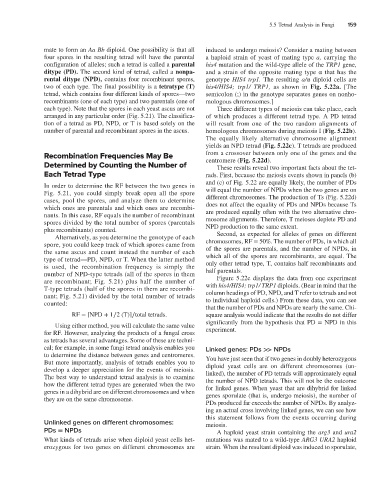Page 167 - Genetics_From_Genes_to_Genomes_6th_FULL_Part1
P. 167
5.5 Tetrad Analysis in Fungi 159
mate to form an Aa Bb diploid. One possibility is that all induced to undergo meiosis? Consider a mating between
four spores in the resulting tetrad will have the parental a haploid strain of yeast of mating type a, carrying the
configuration of alleles; such a tetrad is called a parental his4 mutation and the wild-type allele of the TRP1 gene,
ditype (PD). The second kind of tetrad, called a nonpa- and a strain of the opposite mating type α that has the
rental ditype (NPD), contains four recombinant spores, genotype HIS4 trp1. The resulting a/α diploid cells are
two of each type. The final possibility is a tetratype (T) his4/HIS4; trp1/ TRP1, as shown in Fig. 5.22a. [The
tetrad, which contains four different kinds of spores—two semicolon (;) in the genotype separates genes on nonho-
recombinants (one of each type) and two parentals (one of mologous chromosomes.]
each type). Note that the spores in each yeast ascus are not Three different types of meiosis can take place, each
arranged in any particular order (Fig. 5.21). The classifica- of which produces a different tetrad type. A PD tetrad
tion of a tetrad as PD, NPD, or T is based solely on the will result from one of the two random alignments of
number of parental and recombinant spores in the ascus. homologous chromosomes during meiosis I (Fig. 5.22b).
The equally likely alternative chromosome alignment
yields an NPD tetrad (Fig. 5.22c). T tetrads are produced
Recombination Frequencies May Be from a crossover between only one of the genes and the
centromere (Fig. 5.22d).
Determined by Counting the Number of These results reveal two important facts about the tet-
Each Tetrad Type rads. First, because the meiosis events shown in panels (b)
In order to determine the RF between the two genes in and (c) of Fig. 5.22 are equally likely, the number of PDs
Fig. 5.21, you could simply break open all the spore will equal the number of NPDs when the two genes are on
cases, pool the spores, and analyze them to determine different chromosomes. The production of Ts (Fig. 5.22d)
which ones are parentals and which ones are recombi- does not affect the equality of PDs and NPDs because Ts
nants. In this case, RF equals the number of recombinant are produced equally often with the two alternative chro-
spores divided by the total number of spores (parentals mosome alignments. Therefore, T meioses deplete PD and
plus recombinants) counted. NPD production to the same extent.
Alternatively, as you determine the genotype of each Second, as expected for alleles of genes on different
spore, you could keep track of which spores came from chromosomes, RF = 50%. The number of PDs, in which all
the same ascus and count instead the number of each of the spores are parentals, and the number of NPDs, in
type of tetrad—PD, NPD, or T. When the latter method which all of the spores are recombinants, are equal. The
is used, the recombination frequency is simply the only other tetrad type, T, contains half recombinants and
number of NPD-type tetrads (all of the spores in them half parentals.
are recombinant; Fig. 5.21) plus half the number of Figure 5.22e displays the data from one experiment
T-type tetrads (half of the spores in them are recombi- with his4/HIS4; trp1/ TRP1 diploids. (Bear in mind that the
nant; Fig. 5.21) divided by the total number of tetrads column headings of PD, NPD, and T refer to tetrads and not
counted: to individual haploid cells.) From these data, you can see
that the number of PDs and NPDs are nearly the same. Chi-
RF = [NPD + 1∕2 (T)]∕total tetrads. square analysis would indicate that the results do not differ
Using either method, you will calculate the same value significantly from the hypothesis that PD = NPD in this
for RF. However, analyzing the products of a fungal cross experiment.
as tetrads has several advantages. Some of these are techni-
cal; for example, in some fungi tetrad analysis enables you Linked genes: PDs >> NPDs
to determine the distance between genes and centromeres. You have just seen that if two genes in doubly heterozygous
But more importantly, analysis of tetrads enables you to diploid yeast cells are on different chromosomes (un-
develop a deeper appreciation for the events of meiosis. linked), the number of PD tetrads will approximately equal
The best way to understand tetrad analysis is to examine the number of NPD tetrads. This will not be the outcome
how the different tetrad types are generated when the two for linked genes. When yeast that are dihybrid for linked
genes in a dihybrid are on different chromosomes and when genes sporulate (that is, undergo meiosis), the number of
they are on the same chromosome.
PDs produced far exceeds the number of NPDs. By analyz-
ing an actual cross involving linked genes, we can see how
this statement follows from the events occurring during
Unlinked genes on different chromosomes: meiosis.
PDs = NPDs A haploid yeast strain containing the arg3 and ura2
What kinds of tetrads arise when diploid yeast cells het- mutations was mated to a wild-type ARG3 URA2 haploid
erozygous for two genes on different chromosomes are strain. When the resultant diploid was induced to sporulate,

